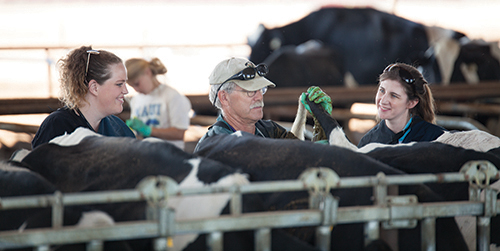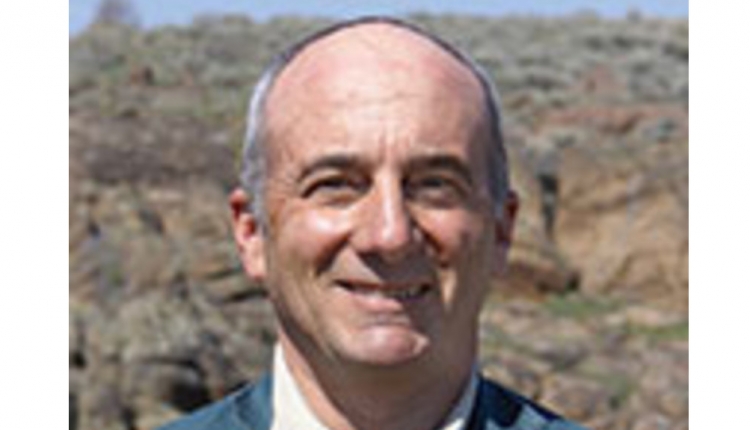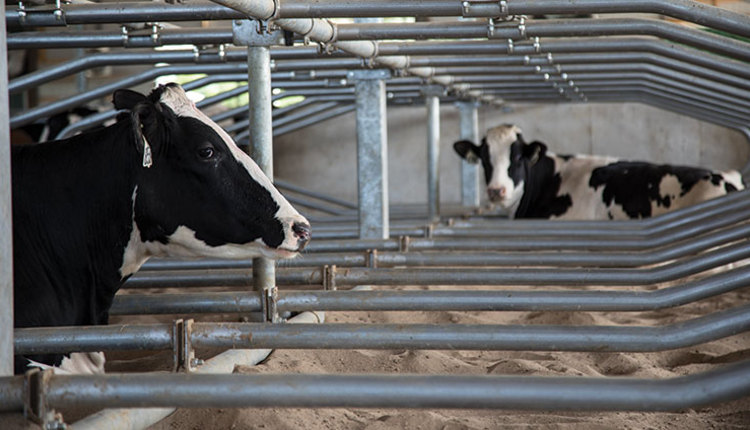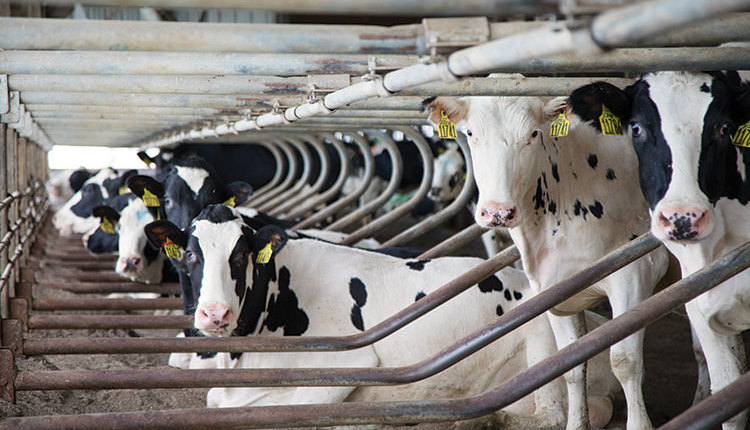The author is a large-herd veterinarian based in Jerome, Idaho.

Escalating veterinary school costs often push new grads toward higher paying jobs in companion animal or corporate practice instead of large animal medicine. To keep young vets in dairy and livestock practice, the USDA's National Institute for Food and Agriculture started the Veterinary Medicine Loan Repayment Program.
German Chancellor Otto Von Bismarck is reported to have said: "Those who love law and sausages should see neither being made." Thus, it was with some trepidation that I flew to Washington, D.C., last fall to serve on a USDA panel. As my jet descended to land at Reagan National Airport, I was treated to a bird's-eye view of the Pentagon, Washington Monument and Capitol buildings.
After landing, I reflected on how I'd come to be invited to our nation's capital. The National Institute for Food and Agriculture, or NIFA, is a department of the USDA that administers the Veterinary Medicine Loan Repayment Program (VMLRP). Earlier this summer, I'd received an email from NIFA requesting that I consider serving on a VMLRP awards panel.
Before deciding, I did some research on the program. Though VMLRP was first authorized in 2003, it was not funded until 2010. Its purpose is to address the existing and projected shortage of food supply veterinarians in the U.S.
The need is there
Due to soaring student loan burdens, many newly graduated veterinarians, despite having an interest in food animal practice, tend to choose comparatively better paying jobs in companion animal or corporate practice instead. To counter this trend and aid in the attraction and retention of vets into food supply practice, the program pays up to $25,000 each year toward qualified educational loans of eligible vets who agree to serve in designated shortage situations for three years.
In the first five cycles of the program, 858 applicants have competed for 291 awards. These awards have totaled over $25 million in loan payments.
Each year, there is a solicitation period announced in the Federal Register for 60 days. Meanwhile, state animal health officials identify food animal supply veterinarian shortages in their states and make nominations. Over 200 such situations are identified each year. The shortages predominantly concern specific geographical areas that lack veterinary coverage but also include veterinary practice specialties such as epidemiology, public health and food safety.
The designated shortage areas (over 90 percent of states typically make nominations) are published on the NIFA website. A request for applications is then posted in the Federal Register. At the close of the application period, applications are reviewed and awards are made. In 2015, $4.4 million (of $5 million appropriated) was available for this purpose.
A thorough evaluation
Each application is evaluated in a two-part process. In the first, they are screened to ensure that they meet administrative requirements. The applicants must be graduate veterinarians with a veterinary student loan burden. They must document a complete history of these loans.
After passing this hurdle, they go to one of two external peer review panels. Typical reviewers are trained and experienced in relevant private and public veterinary fields. The panel originates from diverse geographic regions of the U.S. and varies in age, gender and minority status.
Successful awardees sign a contract that binds them to the terms and conditions for participation in the VMLRP, such as agreeing to secure employment or practice in the designated shortage situation. They must submit a quarterly report that the contract is being honored.
At the end of the three-year period, they and their supervisor submit a termination report with a summary of the services they provided, describe the current state of veterinary services in the shortage situation, and make an assessment of future needs in the region. Finally, they make an appraisal of the overall effectiveness of VMLRP in addressing the shortage situation.
My research intrigued me, so I readily agreed to serve on the panel. Despite having been raised and educated in New England, I'd never been to our nation's capital. After landing on a sultry Monday afternoon, I boarded the Metro subway, emerging in the famous Foggy Bottom station. The city immediately struck me as quiet, clean and well landscaped.
The panel met the next morning in the NIFA building, a modest high-rise situated on the Potomac River. There were 15 of us on the first of two panels. Our backgrounds were intentionally and remarkably diverse: veterinary professionals from academia, private practice and corporate practice from every region of the country. Each panelist brought his or her own unique perspective, experiences and opinions to the table.
After introductions, we quickly got down to business. We'd all done our homework, having already written numerous preliminary reviews in the weeks before the face-to-face meeting. Each application - there were over 60 to review and rank - was initially reviewed by four different peers.
The first or primary reviewer presented his or her review to the panel. The second, third and fourth then got to contribute and comment on the application. It was then opened for discussion to the general panel, concluding with the primary panelist making a preliminary ranking of the merit of the applicant. This process was repeated the next day, until all 60-plus applications were plotted onto a projected grid.
On the third and final morning, the applications were again opened to debate and discussion. This was the last opportunity for us to champion or otherwise change an applicant's ranking before it was locked in.
Each applicant's qualifications were exhaustively discussed. First and foremost in our ranking criteria was if the applicant fit the description of the need in the shortage area. We were privy to the applicant's vet school transcripts, curriculum vitae or résumé, a personal essay about five pages in length, and three references. The combination gave us a detailed picture of the person's abilities, accomplishments and potential suitability to meet the needs of the shortage situation.
USDA directors dropped by to express their appreciation for our service and support of the program. It was a wonderful opportunity for me to see firsthand how Washington, D.C., works and to be able to converse and comment directly with those in charge. My overall impression is that the USDA is run by capable, passionate people who are dedicated to solving the challenges of feeding a growing population. They are also concerned with protecting animal health and addressing producer needs.
I came away from the panel with a renewed and strengthened respect and admiration for the USDA and the VMLRP program. In a world where life is often not fair, the selection and ranking process for loan repayment was transparent, well-thought out and egalitarian.
The NIFA administrators expressed a desire that we in the field get the word out about the program. If you feel that you are in an area that needs veterinary services, let your state vet know and encourage them to make a case for a VMLRP award. If you suspect that your vet may meet the qualifications, please also make them aware of the program. The security of our national food supply is at stake.
This article appears on page 43 of the January 25, 2016 issue of Hoard's Dairyman.
Return to the Hoard's Dairyman feature page.

Escalating veterinary school costs often push new grads toward higher paying jobs in companion animal or corporate practice instead of large animal medicine. To keep young vets in dairy and livestock practice, the USDA's National Institute for Food and Agriculture started the Veterinary Medicine Loan Repayment Program.
German Chancellor Otto Von Bismarck is reported to have said: "Those who love law and sausages should see neither being made." Thus, it was with some trepidation that I flew to Washington, D.C., last fall to serve on a USDA panel. As my jet descended to land at Reagan National Airport, I was treated to a bird's-eye view of the Pentagon, Washington Monument and Capitol buildings.
After landing, I reflected on how I'd come to be invited to our nation's capital. The National Institute for Food and Agriculture, or NIFA, is a department of the USDA that administers the Veterinary Medicine Loan Repayment Program (VMLRP). Earlier this summer, I'd received an email from NIFA requesting that I consider serving on a VMLRP awards panel.
Before deciding, I did some research on the program. Though VMLRP was first authorized in 2003, it was not funded until 2010. Its purpose is to address the existing and projected shortage of food supply veterinarians in the U.S.
The need is there
Due to soaring student loan burdens, many newly graduated veterinarians, despite having an interest in food animal practice, tend to choose comparatively better paying jobs in companion animal or corporate practice instead. To counter this trend and aid in the attraction and retention of vets into food supply practice, the program pays up to $25,000 each year toward qualified educational loans of eligible vets who agree to serve in designated shortage situations for three years.
In the first five cycles of the program, 858 applicants have competed for 291 awards. These awards have totaled over $25 million in loan payments.
Each year, there is a solicitation period announced in the Federal Register for 60 days. Meanwhile, state animal health officials identify food animal supply veterinarian shortages in their states and make nominations. Over 200 such situations are identified each year. The shortages predominantly concern specific geographical areas that lack veterinary coverage but also include veterinary practice specialties such as epidemiology, public health and food safety.
The designated shortage areas (over 90 percent of states typically make nominations) are published on the NIFA website. A request for applications is then posted in the Federal Register. At the close of the application period, applications are reviewed and awards are made. In 2015, $4.4 million (of $5 million appropriated) was available for this purpose.
A thorough evaluation
Each application is evaluated in a two-part process. In the first, they are screened to ensure that they meet administrative requirements. The applicants must be graduate veterinarians with a veterinary student loan burden. They must document a complete history of these loans.
After passing this hurdle, they go to one of two external peer review panels. Typical reviewers are trained and experienced in relevant private and public veterinary fields. The panel originates from diverse geographic regions of the U.S. and varies in age, gender and minority status.
Successful awardees sign a contract that binds them to the terms and conditions for participation in the VMLRP, such as agreeing to secure employment or practice in the designated shortage situation. They must submit a quarterly report that the contract is being honored.
At the end of the three-year period, they and their supervisor submit a termination report with a summary of the services they provided, describe the current state of veterinary services in the shortage situation, and make an assessment of future needs in the region. Finally, they make an appraisal of the overall effectiveness of VMLRP in addressing the shortage situation.
My research intrigued me, so I readily agreed to serve on the panel. Despite having been raised and educated in New England, I'd never been to our nation's capital. After landing on a sultry Monday afternoon, I boarded the Metro subway, emerging in the famous Foggy Bottom station. The city immediately struck me as quiet, clean and well landscaped.
The panel met the next morning in the NIFA building, a modest high-rise situated on the Potomac River. There were 15 of us on the first of two panels. Our backgrounds were intentionally and remarkably diverse: veterinary professionals from academia, private practice and corporate practice from every region of the country. Each panelist brought his or her own unique perspective, experiences and opinions to the table.
After introductions, we quickly got down to business. We'd all done our homework, having already written numerous preliminary reviews in the weeks before the face-to-face meeting. Each application - there were over 60 to review and rank - was initially reviewed by four different peers.
The first or primary reviewer presented his or her review to the panel. The second, third and fourth then got to contribute and comment on the application. It was then opened for discussion to the general panel, concluding with the primary panelist making a preliminary ranking of the merit of the applicant. This process was repeated the next day, until all 60-plus applications were plotted onto a projected grid.
On the third and final morning, the applications were again opened to debate and discussion. This was the last opportunity for us to champion or otherwise change an applicant's ranking before it was locked in.
Each applicant's qualifications were exhaustively discussed. First and foremost in our ranking criteria was if the applicant fit the description of the need in the shortage area. We were privy to the applicant's vet school transcripts, curriculum vitae or résumé, a personal essay about five pages in length, and three references. The combination gave us a detailed picture of the person's abilities, accomplishments and potential suitability to meet the needs of the shortage situation.
USDA directors dropped by to express their appreciation for our service and support of the program. It was a wonderful opportunity for me to see firsthand how Washington, D.C., works and to be able to converse and comment directly with those in charge. My overall impression is that the USDA is run by capable, passionate people who are dedicated to solving the challenges of feeding a growing population. They are also concerned with protecting animal health and addressing producer needs.
I came away from the panel with a renewed and strengthened respect and admiration for the USDA and the VMLRP program. In a world where life is often not fair, the selection and ranking process for loan repayment was transparent, well-thought out and egalitarian.
The NIFA administrators expressed a desire that we in the field get the word out about the program. If you feel that you are in an area that needs veterinary services, let your state vet know and encourage them to make a case for a VMLRP award. If you suspect that your vet may meet the qualifications, please also make them aware of the program. The security of our national food supply is at stake.










